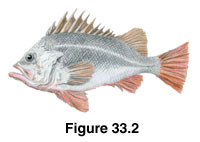 Description
Description
Sebastes brevispinis
(Silvergray Rockfish)
(Other common names: Shortspine Rockfish)
Figure 33.2
 Description
DescriptionLength: 71 cm.
Mouth: large, terminal; maxillary extends posterior to the orbit; lower jaw greatly proturdes in profile; prominent symphyseal knob.
Body: parietal, preocular and nasal spines weak, other head spines absent; supracleithrals well develop; five preopercular but lower one or two can be weak or absent; caudal fin indented.
Color: green to silvery gray; darker on back with silver sides; white below; lips black; paired fins may have tinges of orange-dusky.
Depth: adults in waters 100-375 m; young in shallower waters <100 m.
Habitat: rocky substrates with crevices and caverns; dermersal.
Season: oviviparous; mate in spring; young released in summer; long lived species-up to 80 years.
Diet: forage fish (e.g., herring, sand lance); crustaceans (e.g., crabs, shrimps, euphasiids)
Predators: not determined.
Distribution: southern California to the Bering Sea.
 Scale Description
Scale DescriptionRelative Scale Size: large.
Available Scale Material: below lateral line canal 58-70; in oblique rows (Hart, 1973).
Overall Shape: square to rectangular, depending on the degree of lateral field elongation.
Focus and Circuli: the focus abuts the edge of the posterior field, along the edge of ctenii growth and is approximately one-fifth to one-sixthof the total scale length from the outside edge of the posterior margin. The circuli are continuous between the lateral and anterior fields (except broken by radii) and are tightly compact. The posterior field is quite short and weakly ctenoid.
Radii: numbers are variable and not diagnostic. Radii in the anterior field only. The outer edge of the anterior field ranges from straight to slightly convex and is slightly to moderately scalloped.